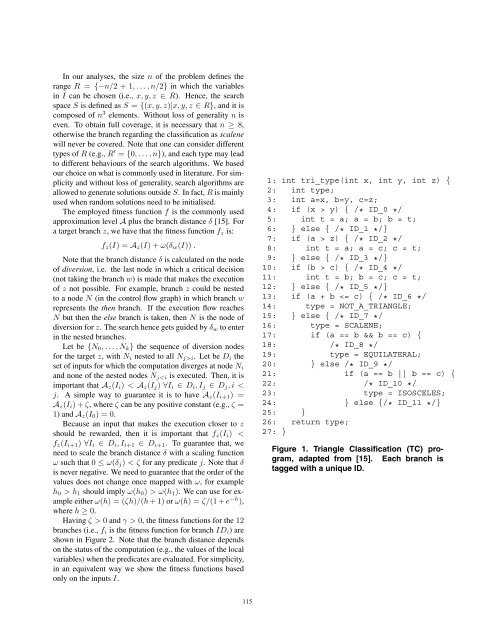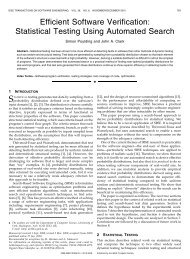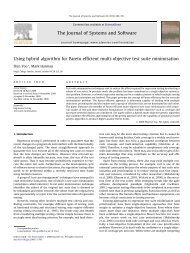necessarily true for high values <strong>of</strong> the size that have not beenempirically tested. Other branches might be more difficult.This is one reason why theoretical analyses are necessary.In this paper, we prove that the expected runtime <strong>of</strong> AVMon all the branches <strong>of</strong> TC is O((log n) 2 ). That is necessaryand sufficient to prove that AVM has a better runtime onTC compared to the other search algorithms we previouslyanalysed. We also carried out an empirical study to integratethe theoretical analysis.The theorems in this paper are also useful for future analyses.In fact, to state that a search algorithm has worse runtimecompared to AVM, it will be just sufficient to provethat its lower bound is higher than Ω((log n) 2 ) on the coverage<strong>of</strong> at least one branch <strong>of</strong> TC.The paper is organised as follows. Section 2 gives backgroundinformation about runtime analysis. Section 3 describesin detail the TC problem, whereas Section 4 describesthe AVM search algorithm. <strong>Theoretical</strong> analyses arepresented in Section 5, whereas the empirical study is discussedin Section 6. Finally, Section 7 concludes the paper.2 <strong>Runtime</strong> <strong>Analysis</strong>To make the notion <strong>of</strong> runtime precise, it is necessary todefine time and size. We defer the discussion on how todefine problem instance size for s<strong>of</strong>tware testing to the nextsection, and define time first.Time can be measured as the number <strong>of</strong> basic operationsin the search heuristic. Usually, the most time-consumingoperation in an iteration <strong>of</strong> a search algorithm is the evaluation<strong>of</strong> the cost function. We therefore adopt the black-boxscenario [4], in which time is measured as the number <strong>of</strong>times the algorithm evaluates the cost function.Definition 1 (<strong>Runtime</strong> [3, 8]). Given a class F <strong>of</strong> cost functionsf i : S i → R, theruntime T A,F (n) <strong>of</strong> a search algorithmA is defined asT A,F (n) := max {T A,f | f ∈Fwith l(f) =n} ,where l(f) is the problem instance size, and T A,f is thenumber <strong>of</strong> times algorithm A evaluates the cost function funtil the optimal value <strong>of</strong> f is evaluated for the first time.A typical search algorithm A is randomised. Hence, thecorresponding runtime T A,F (n) will be a random variable.The runtime analysis will therefore seek to estimate properties<strong>of</strong> the distribution <strong>of</strong> random variable T A,F (n), in particularthe expected runtime E [T A,F (n)] and the successprobability Pr [T A,F (n) ≤ t(n)] for a given time boundt(n). More details can be found in [1].The last decades <strong>of</strong> research in the area show that it isimportant to apply appropriate mathematical techniques toget good results [22]. Initial studies <strong>of</strong> exact Markov chainmodels <strong>of</strong> search heuristics were not fruitful, except for thethe simplest cases.A more successful and particularly versatile techniquehas been so-called drift analysis [8, 19], where one introducesa potential function which measures the distance fromany search point to the global optimum. By estimating theexpected one-step drift towards the optimum with respectto the potential function, one can deduce expected runtimeand success probability.In addition to drift analysis, the wide range <strong>of</strong> techniquesused in the study <strong>of</strong> randomised algorithms [17], in particularChern<strong>of</strong>f bounds, have proved useful also for evolutionaryalgorithms.3 Triangle Classification ProblemTC is the most famous problem in s<strong>of</strong>tware testing. Itopens the classic 1979 book <strong>of</strong> Myers [18], and has beenused and studied since early 70s. Nowadays, TC is stillwidely used in many publications (e.g., [14, 23, 15, 11, 16,24]).We use the implementation for the TC problem that waspublished in the survey by McMinn [15] (see Figure 1).Some slight modifications to the program have been introducedfor clarity.A solution to the testing problem is represented as a vectorI =(x, y, z) <strong>of</strong> three integer variables. We call (a, b, c)the permutation in ascending order <strong>of</strong> I. For example, ifI =(3, 5, 1), then (a, b, c) =(1, 3, 5).There is the problem to define what is the size <strong>of</strong> an instancefor TC. In fact, the goal <strong>of</strong> runtime analysis is notabout calculating the exact number <strong>of</strong> steps required forfinding a solution. On the other hand, the runtime complexity<strong>of</strong> an algorithm gives us insight <strong>of</strong> scalability <strong>of</strong> thesearch algorithm. The problem is that TC takes as input afixed number <strong>of</strong> variables, and the structure <strong>of</strong> its sourcecode does not change. Hence, what is the size in TC? Wechose to consider the range for the input variables for thesize <strong>of</strong> TC. In fact, it is a common practise in s<strong>of</strong>tware testingto put constraints on the values <strong>of</strong> the input variables toreduce the search effort. For example, if a function takesas input 32 bit integers, instead <strong>of</strong> doing a search throughover four billion values, a range like {0,...,1000} mightbe considered for speeding up the search.Limits on the input variables are always present in theform <strong>of</strong> bit representation size. For example, the same piece<strong>of</strong> code might be either run on machine that has 8 bit integersor on another that uses 32 bits. What will happen ifwe want to do a search for test data on the same code thatruns on a 64 bit machine? Therefore, using the range <strong>of</strong> theinput variables as the size <strong>of</strong> the problem seems an appropriatechoice.114
In our analyses, the size n <strong>of</strong> the problem defines therange R = {−n/2 +1,...,n/2} in which the variablesin I can be chosen (i.e., x, y, z ∈ R). Hence, the searchspace S is defined as S = {(x, y, z)|x, y, z ∈ R}, and it iscomposed <strong>of</strong> n 3 elements. Without loss <strong>of</strong> generality n iseven. To obtain full coverage, it is necessary that n ≥ 8,otherwise the branch regarding the classification as scalenewill never be covered. Note that one can consider differenttypes <strong>of</strong> R (e.g., R ′ = {0,...,n}), and each type may leadto different behaviours <strong>of</strong> the search algorithms. We basedour choice on what is commonly used in literature. For simplicityand without loss <strong>of</strong> generality, search algorithms areallowed to generate solutions outside S. In fact, R is mainlyused when random solutions need to be initialised.The employed fitness function f is the commonly usedapproximation level A plus the branch distance δ [15]. Fora target branch z, we have that the fitness function f z is:f z (I) =A z (I)+ω(δ w (I)) .Note that the branch distance δ is calculated on the node<strong>of</strong> diversion, i.e. the last node in which a critical decision(not taking the branch w) is made that makes the execution<strong>of</strong> z not possible. For example, branch z could be nestedto a node N (in the control flow graph) in which branch wrepresents the then branch. If the execution flow reachesN but then the else branch is taken, then N is the node <strong>of</strong>diversion for z. The search hence gets guided by δ w to enterin the nested branches.Let be {N 0 ,...,N k } the sequence <strong>of</strong> diversion nodesfor the target z, with N i nested to all N j>i . Let be D i theset <strong>of</strong> inputs for which the computation diverges at node N iand none <strong>of</strong> the nested nodes N j0, the fitness functions for the 12branches (i.e., f i is the fitness function for branch ID i )areshown in Figure 2. Note that the branch distance dependson the status <strong>of</strong> the computation (e.g., the values <strong>of</strong> the localvariables) when the predicates are evaluated. For simplicity,in an equivalent way we show the fitness functions basedonly on the inputs I.1: int tri_type(int x, int y, int z) {2: int type;3: int a=x, b=y, c=z;4: if (x > y) { /* ID_0 */5: int t = a; a = b; b = t;6: } else { /* ID_1 */}7: if (a > z) { /* ID_2 */8: int t = a; a = c; c = t;9: } else { /* ID_3 */}10: if (b > c) { /* ID_4 */11: int t = b; b = c; c = t;12: } else { /* ID_5 */}13: if (a + b







